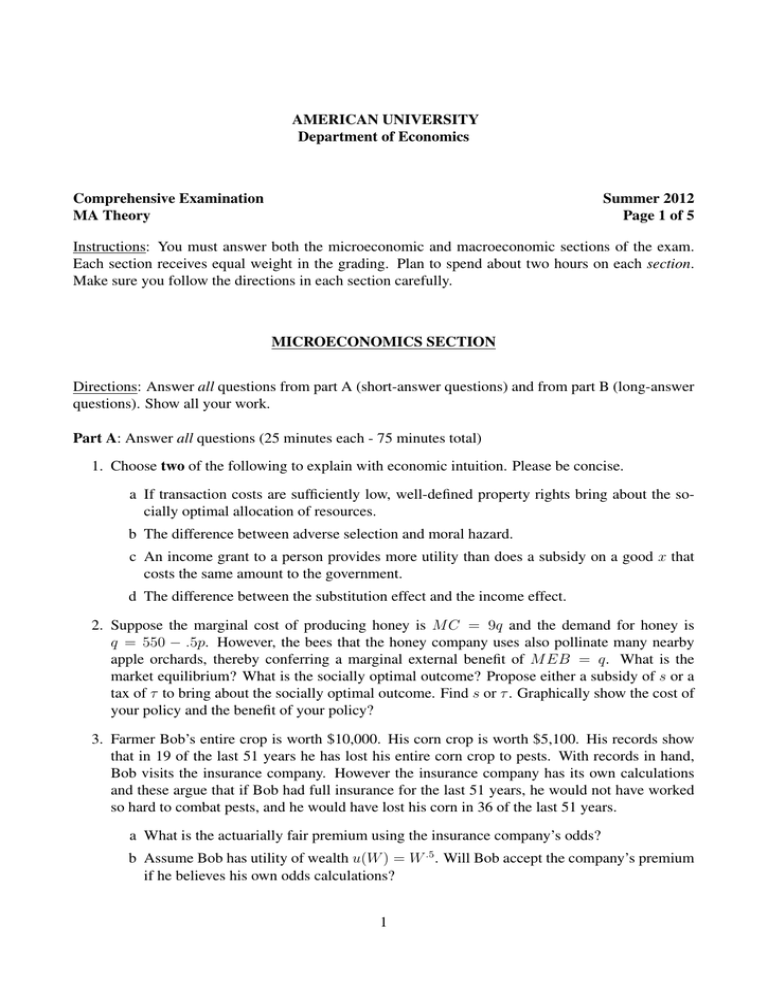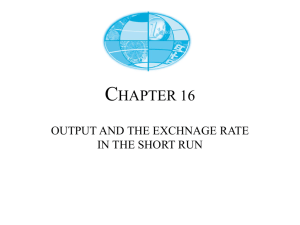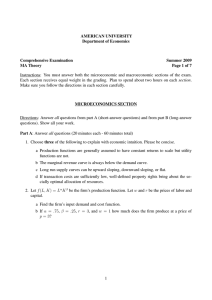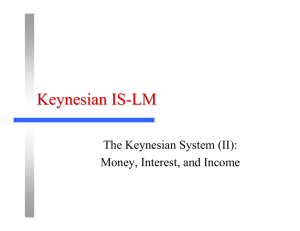AMERICAN UNIVERSITY Department of Economics Comprehensive Examination Summer 2012
advertisement

AMERICAN UNIVERSITY Department of Economics Comprehensive Examination MA Theory Summer 2012 Page 1 of 5 Instructions: You must answer both the microeconomic and macroeconomic sections of the exam. Each section receives equal weight in the grading. Plan to spend about two hours on each section. Make sure you follow the directions in each section carefully. MICROECONOMICS SECTION Directions: Answer all questions from part A (short-answer questions) and from part B (long-answer questions). Show all your work. Part A: Answer all questions (25 minutes each - 75 minutes total) 1. Choose two of the following to explain with economic intuition. Please be concise. a If transaction costs are sufficiently low, well-defined property rights bring about the socially optimal allocation of resources. b The difference between adverse selection and moral hazard. c An income grant to a person provides more utility than does a subsidy on a good x that costs the same amount to the government. d The difference between the substitution effect and the income effect. 2. Suppose the marginal cost of producing honey is M C = 9q and the demand for honey is q = 550 − .5p. However, the bees that the honey company uses also pollinate many nearby apple orchards, thereby conferring a marginal external benefit of M EB = q. What is the market equilibrium? What is the socially optimal outcome? Propose either a subsidy of s or a tax of τ to bring about the socially optimal outcome. Find s or τ . Graphically show the cost of your policy and the benefit of your policy? 3. Farmer Bob’s entire crop is worth $10,000. His corn crop is worth $5,100. His records show that in 19 of the last 51 years he has lost his entire corn crop to pests. With records in hand, Bob visits the insurance company. However the insurance company has its own calculations and these argue that if Bob had full insurance for the last 51 years, he would not have worked so hard to combat pests, and he would have lost his corn in 36 of the last 51 years. a What is the actuarially fair premium using the insurance company’s odds? b Assume Bob has utility of wealth u(W ) = W .5 . Will Bob accept the company’s premium if he believes his own odds calculations? 1 Part B: Answer all questions (75 minutes total) 1. Suppose 10 firms produce pipes, each with the following total cost function C(q) = wa rb q 2 . a Find the individual firm supply curve. b Find the individual firm input demand for K and L. c Find the market supply curve. d Find the elasticity of market supply. e Assume production function exhibits constant returns to scale. Describe what happens to market supply when w, r, and p all increase by 50%? f Find the firm’s profit curve, π(p). 2. Mr. A derives utility from martinis (m) in proportion to the number he drinks: U (m) = m. Mr. A is very particular about his martinis, however: He only enjoys them made in the exact proportion of two parts gin (g) to one part vermouth (v). Hence, we can write Mr. A’s utility function as g U (m) = U (g, v) = min( , v). 2 a Calculate the demand functions for g and v. b Graph Mr. A’s budget line, indifference curve and consumption bundle on the (g, v) axis. c Using the results from part (a), what is Mr. A’s utility as a function of prices and budget? d Calculate Mr. A’s expenditure function. e Compare Mr. A’s happiness between the situation you graphed in part (b) and the following situation: an increase in pg and a lump-sum payment to Mr. A such that Mr. A can still exactly afford the bundle from part (b). 2 Points will be proportional to the time limits indicated. Part A – Short Answer Questions (Identifications) Choose three (3) of the following. For each one you choose, you must give a definition and briefly discuss the significance of the concept for macro theory or policy. You may provide examples, but note that these do not substitute for definitions. Time limit: 10 minutes each (30 minutes total). 1. Quantitative easing 2. Current account 3. Unemployment rate 4. Real exchange rate 5. Golden-rule level of capital 6. Policy trilemma 7. Confidence multiplier 8. Primary deficit 9. Automatic stabilizer 10. Monetary neutrality 11. Taylor rule 12. Total factor productivity Part B – Long Answer Questions (Problems/Models) Choose two (2) of the following. Time limits: 60 minutes each (120 minutes total) 1. Many countries are currently pursuing a combination of economic policies. Analyze the situation of a reduction in government spending along with expansionary monetary policy. Discuss the implications of this policy for any three (3) of the following cases, assuming a short-run analysis. Your analysis can be mainly graphical and must include detailed explanations. You may include equations if you wish. Also, you must show the changes on central bank balance where relevant. Under what conditions will a recession be the result of these policies? Discuss. a. Closed economy IS-LM model (with the traditional LM curve). b. IS-MP model, closed economy, where MP is the “monetary policy” curve assuming the central bank targets the interest rate (does it matter if the central bank has a constant interest rate target or follows a Taylor rule? show/discuss). c. Open economy IS-LM model, with free capital mobility (so that the interest parity relation holds) and a flexible exchange rate. d. Open economy IS-LM model, with free capital mobility (so that the interest parity relation holds) and a fixed exchange rate. (Part B continues on the next page) 3 2. Analyze the short-run and medium-run effects of each of the following on output (or the unemployment rate) and the price level (or inflation rate), using either the aggregatesupply/aggregate-demand model (AS-AD) or an expectations-augmented Phillips Curve model (you do not need to use both). Be sure to explain how the economy (supposedly) adjusts from the new short-run equilibrium to the new medium-run equilibrium, discuss the role of price expectations, and assess whether the theoretical adjustment process is realistic or not in each case. You may assume that the economy starts in an initial medium-run equilibrium at the “natural” output level Yn or “natural” rate of unemployment un in each situation. a. A negative supply shock, such as a rise in the price of oil. b. A cut in unemployment benefits. c. A positive shock to aggregate demand, due to an increase in consumer confidence. 3. Derive algebraically and explain intuitively the steady-state equilibrium condition in the Solow Growth model (neoclassical growth model). Use the graph of the Solow model to analyze the effects of each of the following changes (considered separately) on long-run equilibrium: a. A fall in the growth rate of the population b. A rise in the saving rate c. A rise in the rate of technical progress For each case, what is the change in the growth rate of output, output per worker, and output per effective worker? Summarize and explain the reasoning. Finally, consider whether or not a policy to raise the saving rate would be a good idea (e.g. is it possible for an economy to have too much capital?). 4. Compare and contrast the long-run effects of an increase in the saving rate in an exogenous growth model (such as the Solow model) and an endogenous growth model. Make specific reference to the steady state in each case. (Your detailed graphical exposition must be accompanied by extensive economic explanations.) 5. Many countries pursued a policy of fiscal expansion as a reaction to the Great Recession. (a) Consider the closed economy IS-LM and AD-AS model and analyze the short run and medium run implications of fiscal expansion for real GDP, interest rates and the price level. Provide a detailed explanation. (b) What are the implications for your analysis if the economy is in a liquidity trap? Demonstrate with new graphs and a new explanation. (c) Use the government budget constraint to discuss the potential long run consequences for the debt/GDP ratio. Be specific. (d) Are there any special aspects of the US economy that affect the risks presented by the accumulated debt? Explain. (e) What adjustments could enhance the effectiveness of fiscal policy in the future? 6. (a) Use the wage-setting and price-setting (WS-PS) framework to DERIVE the aggregate supply (AS) curve. Show and explain all equations. (b) Consider an unexpected fall in the price of energy. Use the AD-AS model to explain how this would affect the economy in both the short run and the medium run. Pay special attention to the transition to the medium run. Be as complete as possible. (c) If the central bank wanted to limit the 4 change in the price level, how should it proceed? Will it be successful in both the short run and the medium run? Show and explain on a new set of graphs. 5









